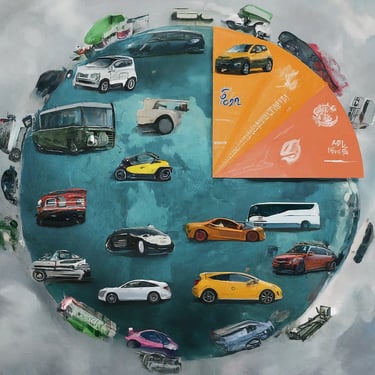The Rising Tide of EVs and the Surging Demand for Electricity
As global initiatives push towards a more sustainable future, electric vehicles (EVs) are at the forefront of reducing carbon emissions in the transportation sector. However, the rapid adoption of EVs also brings significant challenges, particularly in terms of the increased demand for electricity. This detailed analysis explores the implications of this demand, its current sourcing from fossil fuels, and how innovative technologies could potentially mitigate the associated environmental impacts.
Projected Electricity Demand by EVs (Reference)
Understanding the growth in electricity demand is crucial for planning and policy-making. The following tables and analysis provide a year-by-year breakdown of expected electricity demand from electric vehicles, emphasizing the scale and urgency of the issue.
Percentage Increase in Electricity Demand(only cars. other vehicle types are not included):
From 2020 to 2021: 64.78%
From 2021 to 2022: 25.11%
From 2022 to 2023: 122.83%
From 2023 to 2025: 125.21%
From 2025 to 2030: 225.41%
From 2030 to 2035: 97.40%
These numbers show a significant and increasing demand for electricity due to electric vehicles, with major jumps particularly from 2022 to 2023 and from 2025 to 2030. The total projected percent increase in electricity demand for electric cars from 2020 to 2030 is approximately 3266.43%. This indicates a substantial increase, reflecting the significant growth expected in the adoption of electric vehicles and their impact on electricity consumption over the decade
Reliance on Fossil Fuels for EV Energy Demand
Currently, a significant portion of the electricity used to charge EVs comes from fossil fuels. This section analyzes the proportion of energy sourced from non-renewable versus renewable sources and discusses the implications for carbon emissions and environmental sustainability.
How does the source of electricity impact the environmental benefits of electric vehicles?
The source of electricity is crucial in determining the environmental impact of electric vehicles. If the electricity is generated from renewable sources, EVs can significantly reduce carbon emissions and air pollutants. However, if the electricity comes from fossil fuels, the benefits are lessened as burning fossil fuels for electricity generation produces emissions.
What percentage of global electricity is generated from fossil fuels, and how does this affect EVs?
As of the latest data, fossil fuels account for about 60-65% of global electricity production. This high reliance means that many EVs are still indirectly emitting greenhouse gases due to fossil-fuel-based electricity generation.
Environmental and Economic Implications
The dependency on non-renewable energy sources not only contradicts the environmental goals of EV adoption but also poses significant risks to economic stability and energy security. Increased demand could lead to higher emissions unless there is a substantial shift towards renewable energy.
Innovative Solutions by dhope.org
dhope.org proposes a groundbreaking technology that allows EVs to charge while in motion using aerodynamic forces, potentially reducing the need for traditional charging stations and lessening the load on the power grid. This technology could potentially convert the kinetic energy from air resistance into electrical energy, which in turn could be used to charge the vehicle’s battery. Additionally, by reducing drag, it enhances the vehicle's efficiency, extending the range per charge.
How the Technology Works
Energy Harvesting from Aerodynamic Forces: Devices or mechanisms could be integrated into the vehicle’s structure that capture energy from the airflow around the vehicle as it moves.
Drag Reduction: Simultaneously, the design incorporates features that minimize aerodynamic drag.
Potential Impact on Electricity Demand and EV Efficiency
Reduced Charging Needs: By generating electricity on the go, this technology could decrease the frequency and necessity of stationary charging, reducing the load on electrical grids, especially during peak times.
Increased Range: Improvements in aerodynamic efficiency translate directly into greater range for EVs, as less energy is wasted overcoming air resistance.
Enhanced Grid Stability: With a reduced need for frequent grid-based charging, there's less strain on energy infrastructure, which is crucial as the number of EVs increases globally.
How does on-the-go charging technology influence the sustainability of electric vehicles?
This technology enhances sustainability by reducing reliance on grid electricity, much of which is still generated from fossil fuels globally. It increases the proportion of energy derived from renewable or regenerated sources directly associated with the vehicle’s operation
Scenario Comparison: Current Trends vs. Innovative Futures
Current Trends
The rapid adoption of electric vehicles (EVs) is projected to significantly increase global electricity demand, with much of this demand still met by fossil-fueled power plants. This reliance could diminish the environmental benefits of EVs and necessitate costly upgrades to electrical infrastructure to manage peak loads.
Innovative Futures with dhope.org's Technology
dhope.org proposes a novel technology that enables EVs to charge using aerodynamic forces while driving, potentially reducing the need for grid-dependent charging stations. This technology not only lessens the load on the power grid during peak times but also enhances vehicle efficiency by reducing drag.
Comparative Analysis
Energy Consumption: Traditional charging methods are likely to increase fossil fuel use unless matched by a rise in renewable energy sources. In contrast, dhope.org’s technology could decrease overall electricity demand by improving charging efficiency and vehicle aerodynamics.
Infrastructure Needs: Current trends may require extensive investments in new charging infrastructure and grid upgrades. The innovative technology offers a less resource-intensive alternative by reducing the need for such infrastructure.
Environmental Impact: While traditional EV adoption reduces tailpipe emissions, the full environmental potential is compromised by continued fossil fuel reliance. dhope.org’s technology promises a more comprehensive reduction in emissions by enhancing the sustainability of EV charging.
This comparison highlights the potential of dhope.org’s innovative technology to address critical challenges in the EV sector, promoting a faster, more sustainable transition to electric mobility.
Conclusion
As the EV market continues to expand, addressing the electricity demand and its sourcing becomes paramount. By integrating innovative technologies like those developed by dhope.org, we can ensure that the transition to electric mobility is both sustainable and beneficial to society at large.
















